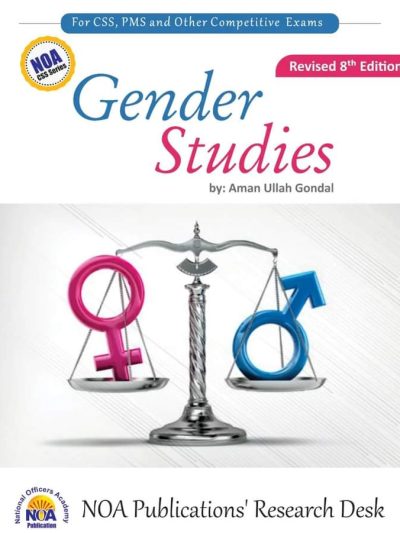Gender Studies By Aman Ullah Gondal (NOA Publication)
Best For Competitive Exams (CSS,PMS,PCS & All Descriptive Exams)
Preface to English Edition
To me the discipline of Gender Studies and gender related concepts became a source of inquisitiveness during my M. Phil research work on the topic Gender Based Violence, followed by my association with Gender Reforms Action Plan, Government of the Punjab as Program Officer, it not only provided me an opportunity for detailed exploration of Gender Studies as a discipline but also enabled me to transcribe this publication for CSS aspirants who choose Gender Studies as an optional subject.
It was not an essay task to write this manuscript for the CSS aspirants since there was a sheer difference in needs and requirements of CSS candidates than that of those who study Gender as a discipline in universities at Masters or above levels, here, efforts have been made to address the felt needs of the both.
Here I am indebted to all the teachers and friends who were source of guidance and encouragement during the course of writing this book.
I am thankful to Mr. Atif Ali (CEO NOA), Hassan Ali Gondal and team NOA Publications Islamabad for their kind consideration and consistent motivation towards writing this book.
Aman Ullah Gondal
M. Phil Social Sciences
PMS/FSP
CONTENTS
Section ~ I ~ Understanding Basics of Gender Studies.
What is Gender?
Ø Origin
Ø Definition
Ø Sex
Ø Key issues to be Noted in Definition of Gender
Ø Difference between Sex and Gender
Ø Exploring What Gender refers to…?
Ø Key Differences between Two Terms
What is Gender Studies?
Ø Defining Gender Studies
Ø Understanding Gender Studies
Ø Focus of Gender Studies
Ø Defining Women’s Studies
Ø Development of Women’s Studies
Ø Emergence of Men’s Studies
Ø Development of Men’s Studies
Ø From Women’s Studies and Men’s Studies to ‘Gender Studies’
Ø Gender Studies as all inclusive
Ø Why there is More Focus on Women than Men?
Ø Importance of Gender Studies
Ø History and Evolution
Ø 2nd Wave Feminism and Development as an Academic Discipline
Ø Growth of Gender Studies
Ø Features of the Discipline
Ø Difference between Women’s Studies and Gender Studies
Ø Conclusion
Evolution as an Academic Discipline
Ø Introduction
Ø Evolution as an Academic Discipline
Ø The History and development of Women’s Studies
Section-I
Understanding Basics of Gender Studies
· What is Gender?
· What is Gender Studies?
· Evolution as an Academic Discipline
· Gender Studies in Pakistan
· Gender Studies – Multidisciplinary in Nature
What is Gender?
Ø Origin
Originally 'Gender' is a grammatical term borrowed from linguistics; it is the collective term for the categories of masculine or feminine or neuter into which nouns of many languages are allocated.
Anthropology borrowed the term to discuss the social roles occupied by males and females in society. Historians the world over have accepted the challenge of a new global perspective on women's and gender history as mentioned by Oliver Janz in Gender History in a Transnational Perspective. The gendered roles in society were assumed to be the 'natural' result of one's sex, but cross-cultural studies demonstrate that while sex is a universal condition of humans, gender roles vary across culture.
Ø Definition
"Gender is seen as the process by which individuals who are born into biological categories of male or female become the social categories of men and women through the acquisition of locally-defined attributes of masculinity and femininity
Gender refers to the attitudes, feelings, and behaviors that a given culture associates with a person's biological sex. Behavior that is compatible with cultural expectations is referred to as gender-normative; behaviors that are viewed as incompatible with these expectations constitute gender non-conformity.
Ø Sex
Sex is a concept that emerges from anatomical and physiological characteristics that differentiates males and females biologically whereas gender can be seen as a social construct manifested by masculine and feminine roles prevalent in a culture or a society. Thus gender can be seen as an artifact of social, cultural and psychological factors which are attained during the process of socialization of an individual.
Sex refers to a person's biological status and is typically categorized as male, female, or intersex (i.e. typical combinations). There are a number of indicators of biological sex, including sex chromosomes, gonads, internal reproductive organs, and external genitalia.
Ø Key issues to be Noted in Definition of Gender
· It is socially and culturally constructed. This means that gender is a matter of socio-cultural construction or definition. It is not innate or in-born. It is defined or assigned within socio-cultural domain.
· Gender role is acquired as a member of a community. Gender roles are learnt, especially through the process of socialization. This also buttresses that it is not a natural condition.
· Gender is dynamic: it changes over time. With any culture, there could be re-definition of gender roles over time. Reeve and Baden (2000) averred that gender identities and associated expectations of roles and responsibilities are, therefore, changeable between and within cultures.
· Gender is defined in relational context. This is relationship between the sexes in any particular culture. These relationships show specific roles attributed to each of the sexes in terms of decision-making, power sharing and division of labour.

